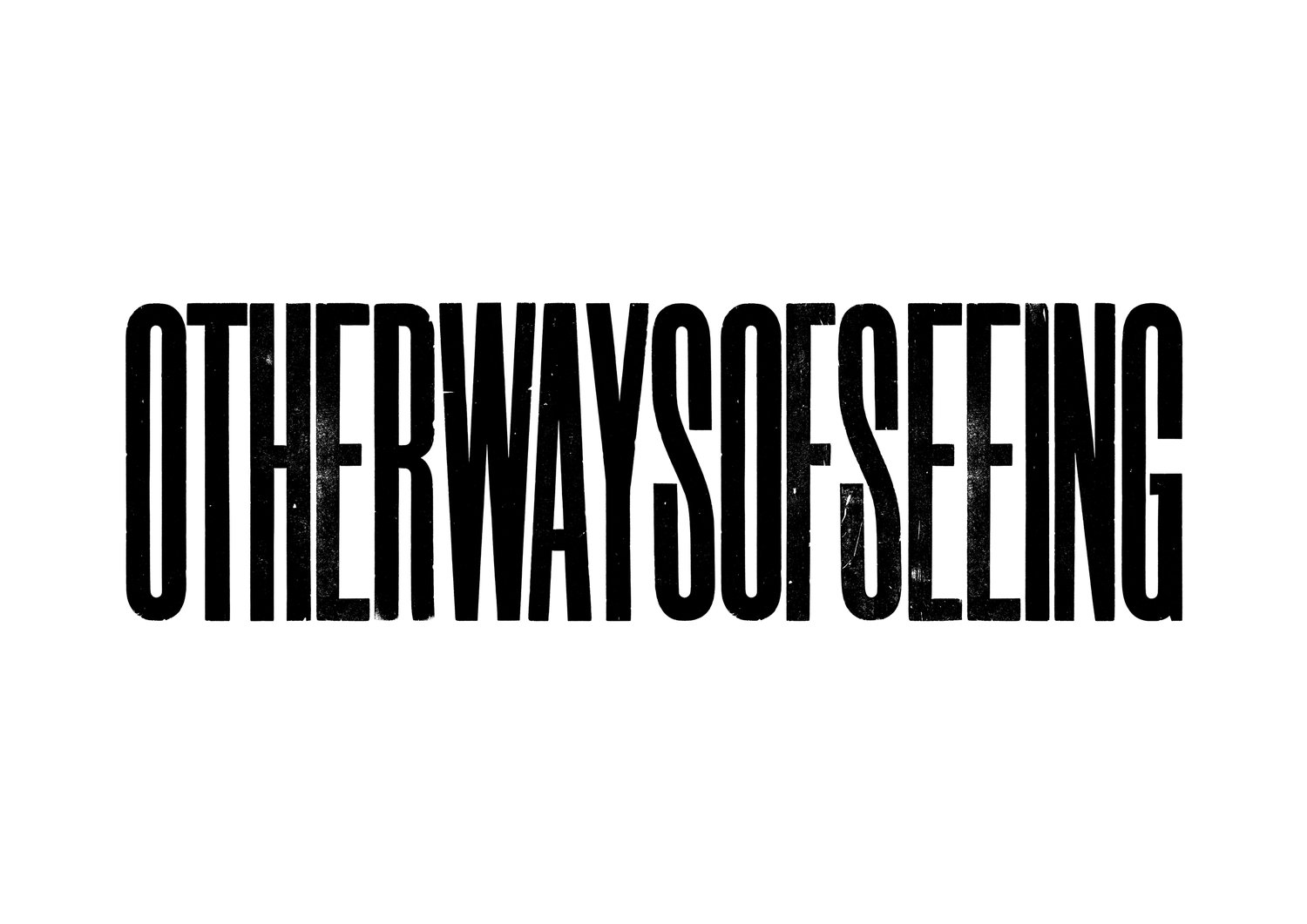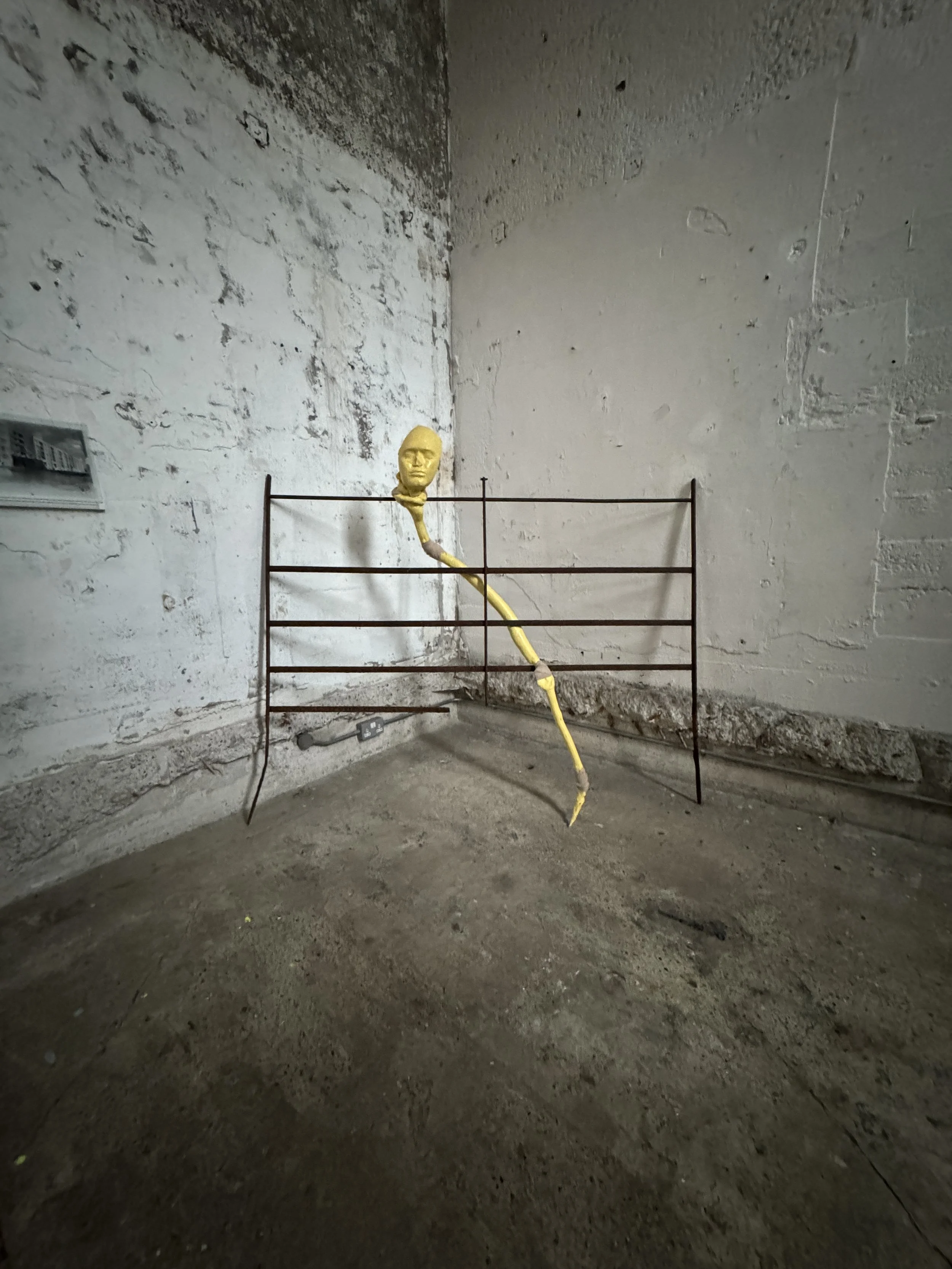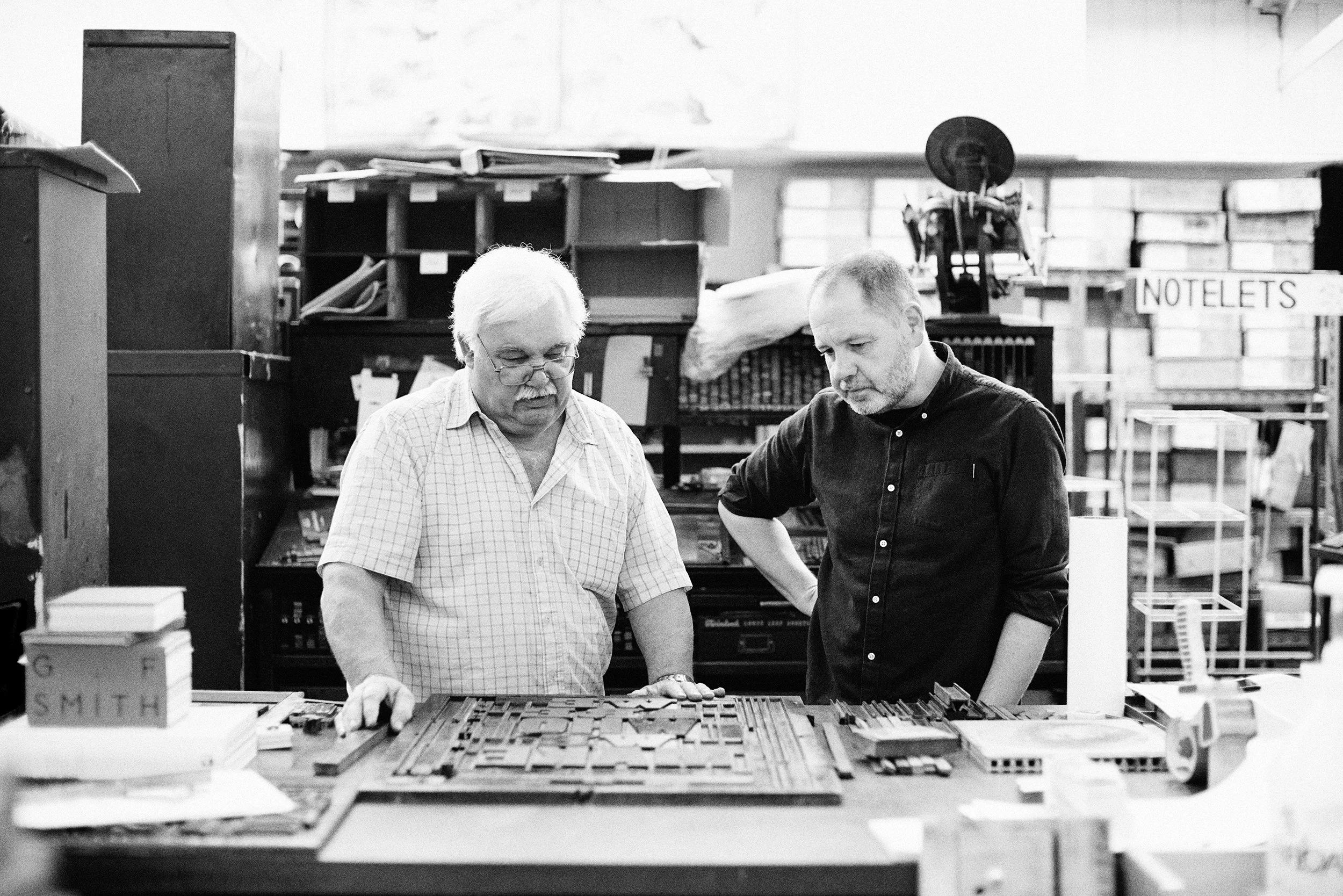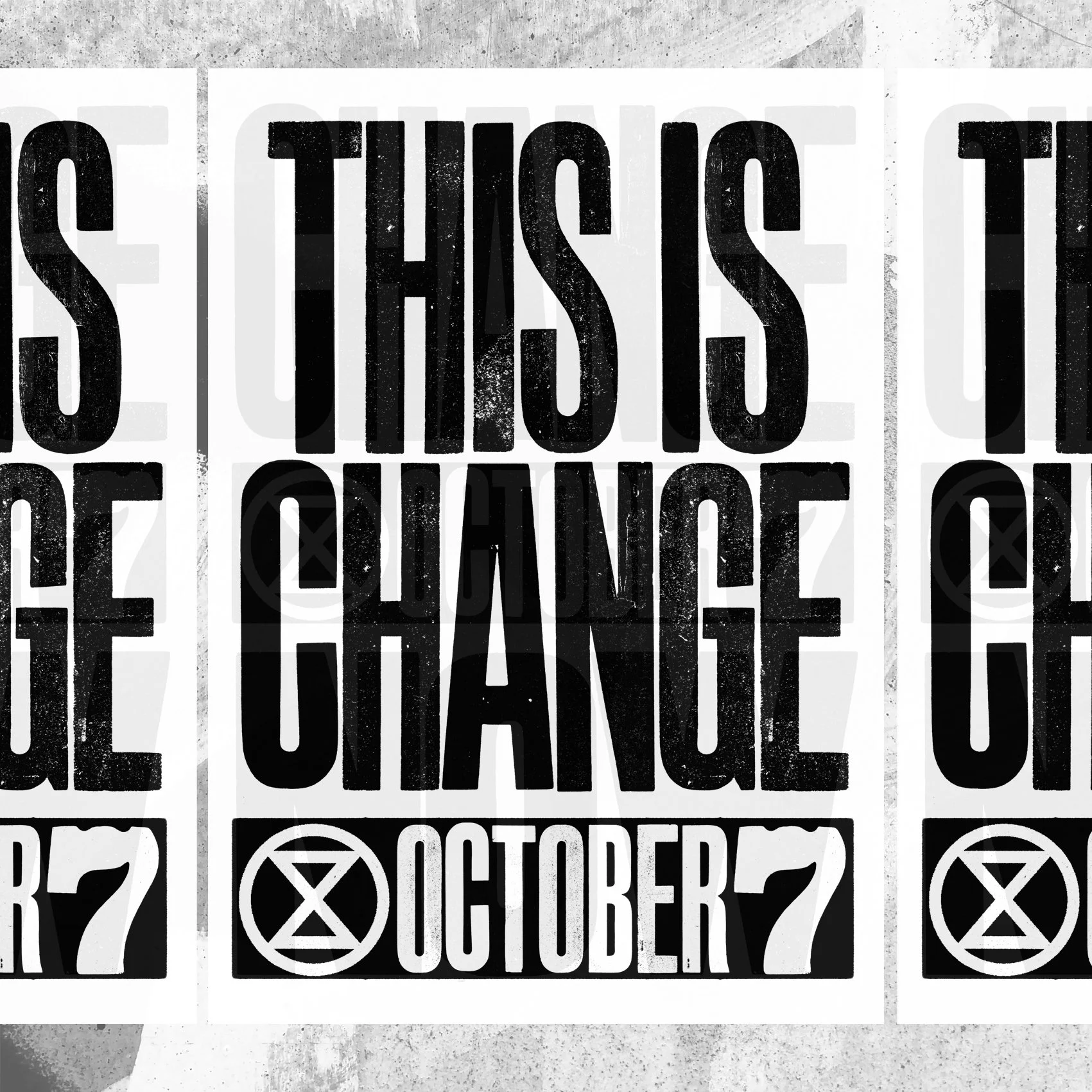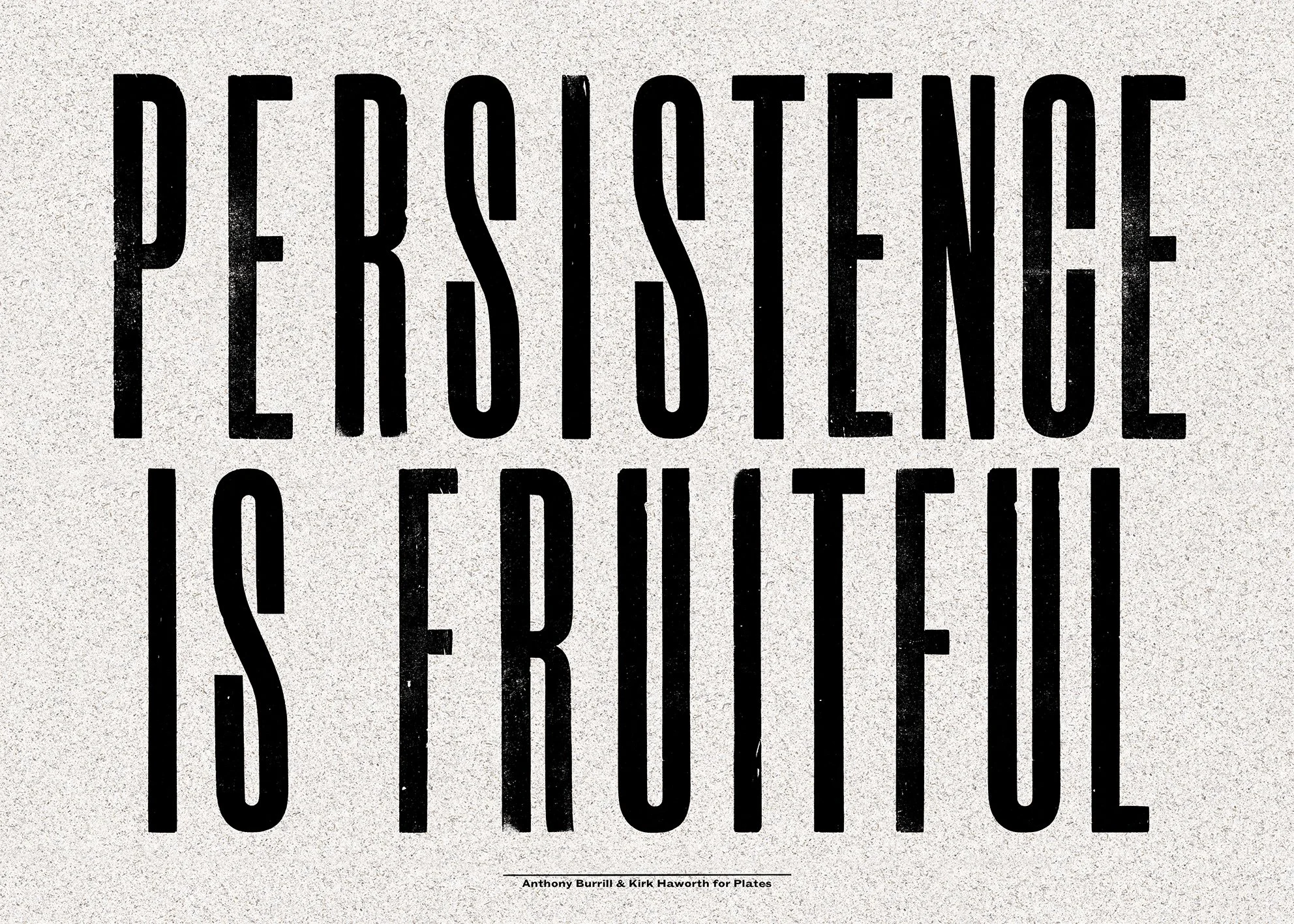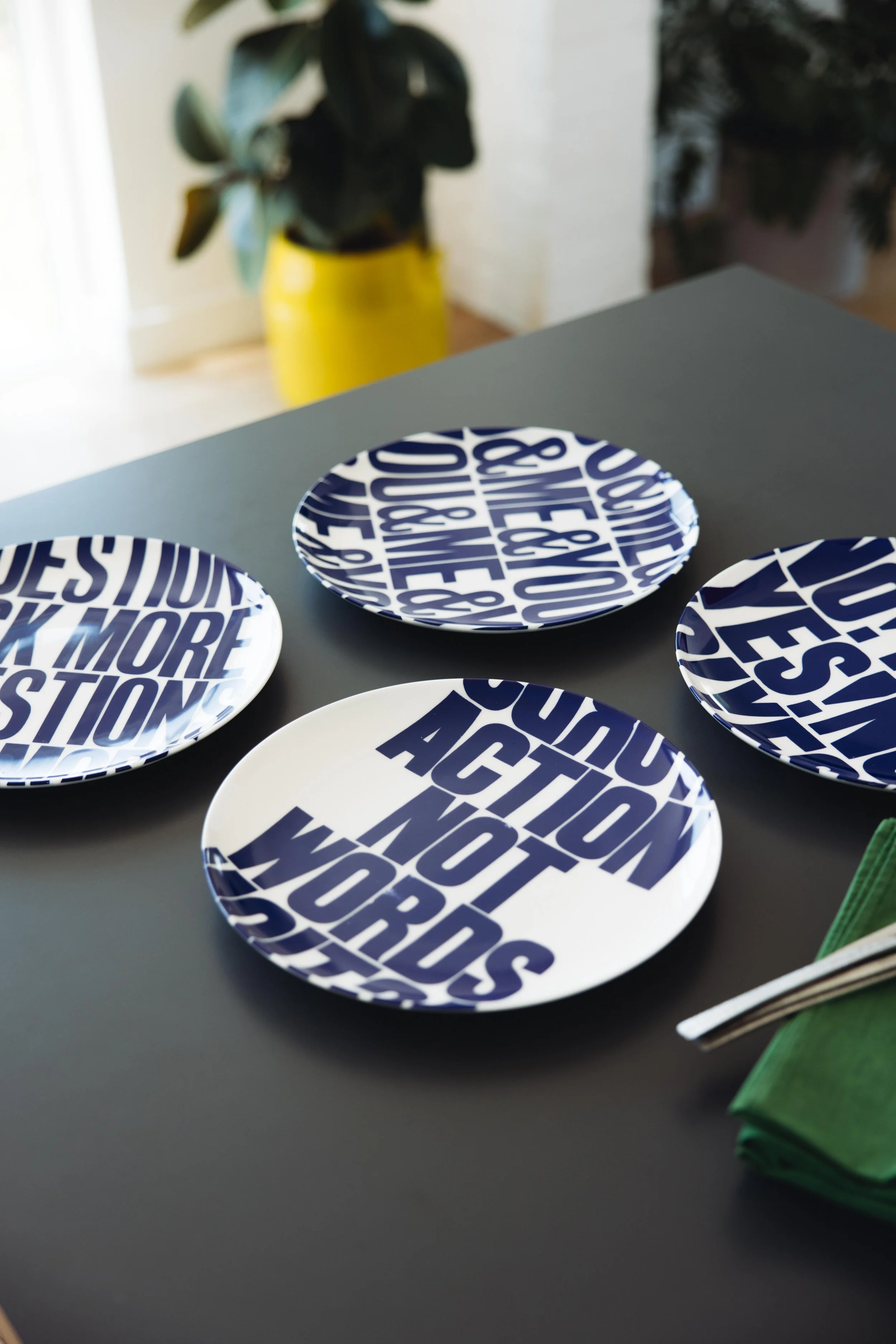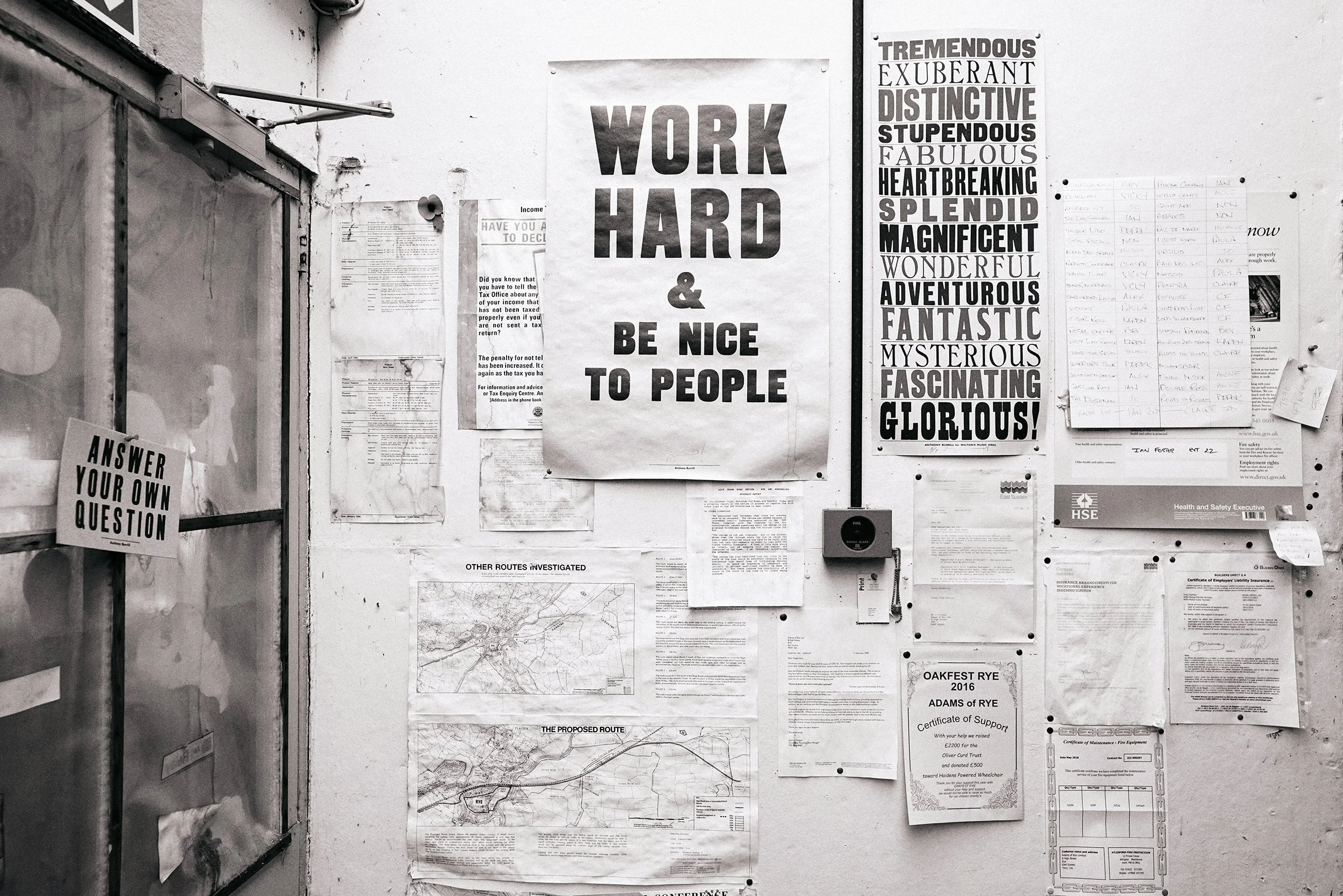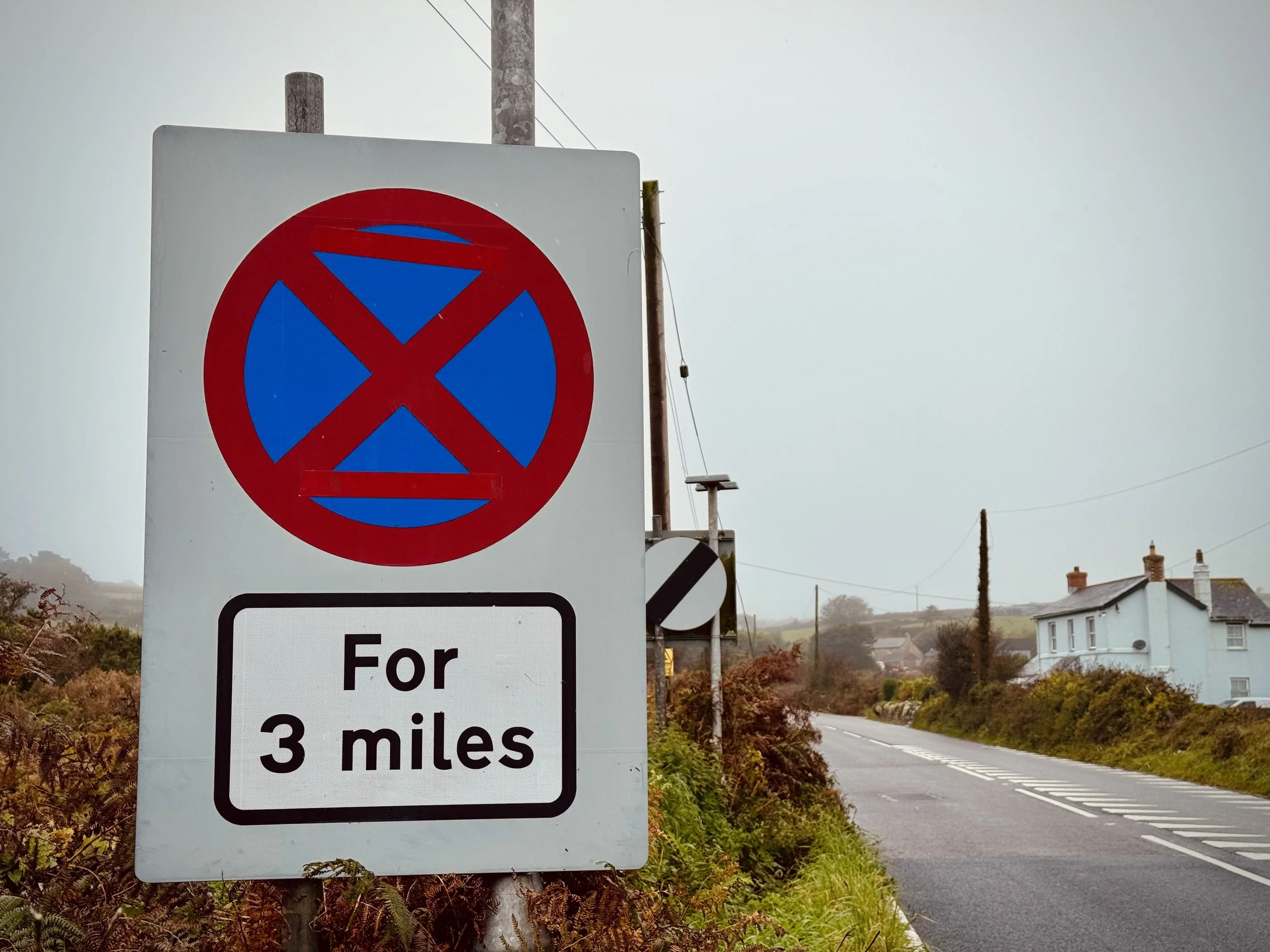ANTHONY BURRILL
Anthony Burrill - photo by Dunja Opalko
Welcome to the third Other Ways of Seeing conversation. Other Ways of Seeing is a project to discover the personal or not so personal art practices of people who work in the creative industries. What they make and why they make it.
This conversation is with Anthony Burrill. Ant is a super famous graphic artist, most well known for his positive aphorisms, in particular his extremely popular poster ‘Work Hard and Be Nice to People’. I think practically every agency and production company had one up on a wall in the mid 2000s. Back then I repped Ant at a company called 2AM (rest in peace) and we’ve been friends ever since. Most importantly he designed the Other Ways of Seeing logo and has been a firm supporter of my crazy schemes over the years. I have to add that Ben McNaughton head of design at advertising agency Mother did actually design me a perfectly awesome logo before I shunned him for Ant’s design, because well Ant’s famous and I’m shallow.. so apologies Ben, I owe you a massive drink.
The conversation was recorded at the end of February 2025, so it’s taken me a long time to get this out. This podcast is still a huge learning curve for me but I love it. Just like all you listeners out there who have jobs and families but are passionate about their art practice and want to spend every spare moment working on it. I’m hoping to release more conversations more often as I get better at this so please bear with me.
So.. we began the conversation talking about his son Jack’s final show for his fine art degree at Camberwell, working solo, collaborating with Oswin Tickler (omg I love his name), keeping on doing what you love, taking commissions, not taking commissions. You & Me & Me & You, the epic piece that’s the size of a building because it’s ON the side of a building! Work that didn’t translate so well, simplifying, trusting your intuition, a wine bar that he sent me pictures of by mistake (glad it was just a wine bar Ant), unfortunate places your work can end up, and the power of a single image.
Mel: What was the last piece of art that kind of blew you away? Apart from Jacks obviously.
A.B.: Yeah, well I think it was Jack’s actually.
Mel: That’s amazing, I love that. Okay, not apart from Jack’s.
A.B.: Yeah, let's talk about that. Because I think it's just seeing somebody's development from being on his course and seeing how that has affected his work and seeing the work of the students around him. And I think just seeing that, the amount of work that they'd all put in for that interim exhibition, you could see the three years, well almost three years that they'd all spent working on or developing their approach to making creative work. Some stuff was really amazingly well crafted and other bits were just like things stuck together in quite a sort of raw way. It's like a real mirror for all of the students' development. So yeah, just kind of being in a space where it was really raw as well. It was maybe the first time that they'd exhibited their work together and a lot of the time the students aren't together so they don't really know what everybody else is doing. So maybe it was a surprise for them to see what everybody else had been working on as well. And there's a real variety and kind of energy to it.
Cross the Fence - Jack Burrill
Beneath the Soil - Jack Burrill
Mel: And what course is this that Jack's doing? Is this a degree, in Fine Art?
A.B.: Yeah.
Mel: And where is it?
A.B.: Camberwell.
Mel: Yeah, that's it. And so why are the students not familiar with their own work? Do they not share studios? Or is it a collective?
A.B.: Yeah, they have shared studio space but not all of them go in all the time. It's not like it was in my day when I was at art college and everybody was in every day. And it was a real social thing. We just kind of sit around in the studios hanging out most of the time really, and that's how we got to know each other's work. But I think with Jack, the social life is more fragmented because he’s at college in London, everyone lives all over the place and it's a bit of a different thing.
Mel: That’s really interesting because when I think about my fine art degree, we were in studios, and because I did big sculpture, I was sort of in the main massive shared studio and it was like you say it was so sociable. And there was lots of cups of tea and talking about each other's work. And you went in every single day. So that's really weird to sort of think that that doesn't happen. And maybe that's a good thing in a way because it kind of prepares you for real life where you're suddenly in a studio by yourself or maybe shared with one other person. And you don't have that kind of that draw into college because of the social aspect of it, so you have to carry on kind of just making. That's really weird…
It just it feels like, especially since COVID and maybe the Internet and and the age of, you know, being able to communicate like this.. there isn't as much of a need to hang out. I mean, you've worked solo for years, haven't you? And you like that, don't you? I mean, it works better for you.
A.B.: Yeah, I think yeah, when I'm actually working, you know, kind of like 100% focused on things. I just like to be in the studio and listening to my, you know, vibey music and not having any interruptions, and I switch off email and everything. But then I kind of contrast that with, you know, when I go over and do screen printing at the screen printers, that’s also a kind of a sociable thing as well. And then I go up to London and do things and, you know, there's real variety. So I think that the main thing for me is having a variety of different experiences. And then when I'm actually in the studio, it's 100% focused on what I’m doing.
Mel: And when do you ever get feedback? So like, do you ever share ideas before they're finalised? Or is it like, “this is my art, and I'm doing it, and I'm not sharing it”? Because, you know, when you are in a shared studio, or if you're collaborating as well, you're always bouncing ideas off each other. But when you're working and you're concentrating on a thing.. do you know exactly what you want? Is that right? Or do you actually, when you go to the printmakers, what if they go, “oh, Anthony, that's not very nice”. Bet they don't do that, but you know..
Adams of Rye - photo by Jane Stockdale
A.B.: Yeah, you know Emma, I show all my work to Emma, she always gives me lots of feedback. And then it's always like, because I've been doing it such a long time, I just know. I know whether it's right or not really. But then, you know, when I'm working at the screen printers, we work on these different materials and whenever I'm printing things, I kind of put different kinds of paper in there and kind of see, test things out. But yeah, I suppose it's like the work I've been doing recently with my friend Oswin Tickler.
Mel: Best name ever.
A.B.: Yeah, yeah.. I’m only friends with him because he's got a great name.
Mel: Good reason.
A.B.: But with that we've been developing this way of working, playing around with coding and letter forms and experimenting with all that stuff. So, it's kind of opened up a whole new area to work within really, it's related to what I've done before, but it's much more abstract. So I've been printing onto sheets of plywood and, larger scale and layering over things. So I'm not quite sure where it's going to lead yet, but it's definitely some little kind of seed of something happening with that.
Mel: So it's just the beginning then really this collaboration.
A.B.: Yeah.
Combined Forms by Anthony Burrill & Oswin Tickler
Mel: You’ve already got.. you have a book, is that right? Of the work that you've done with him already. And I can, I mean, what I've seen from your website, it's amazing. It's sort of, well, it's all abstract, isn't it? But then you feel like you can, you can kind of extract some meaning out of it or it is part of something. I thought it was really beautiful. And is it turning into 3D?
A.B.: Mmm (agreeing noise)..
Mel: Ooh, cool! You’re really good at that Ant. I love those.
Combined Forms by Anthony Burrill & Oswin Tickler
Combined Forms by Anthony Burrill & Oswin Tickler
A.B.: Yeah, so I suppose, it's like one of the things we've written in the book… it's letter forms, kind of taken out, there’s no meaning, there's no text, there are no words. It's just pure shapes. So it's kind of liberated from having to give meaning. But, you know, that's just part of exploring the kind of abstract messed up craziness of it. And I think it's reflected in the world around us at the moment, you know, there's maybe less certainty around and by kind of just exploring this different way of working, it feels like it sort of connects with how we’re all feeling at the moment, you know, just this kind of chaos and lack of understanding of what's going on.
Mel: Yeah, and I guess it's probably quite human of me wanting to try to extract some kind of meaning from the chaos because it comforts one. But, yeah, no, I can see that. And where did that collaboration come from? Is he a mate of yours, or..?
A.B.: Yeah, I've known him for a long time since he was a student, I think he came to see me when he was a student at LCC. And we just stayed friends from then really. I think he's just got a really interesting approach to kind of creative coding, and type, and we both kind of geek out over typefaces together. But I suppose.. you know the way he's writing code to kind of create each type, each image is unique and it's controlled by different parameters and the computer is part of the creativity really. So it's kind of like us and the computers working together.
Mel: And that seems like the complete opposite of your analogue technique.
A.B.: Yeah.
Mel: So that's really interesting that you can come together from like two different poles and create.
A.B.: Yeah, yeah, definitely. And I think it's just that, I suppose, because we're both interested in similar things and it's like, I've got my bit that I do and then Oswin's got the bit that he does. And, you know, we kind of create this new work together that's a kind of combination of both of us. And that's what all collaboration is about, it's like where do you meet in the middle and how do you sort of navigate that stuff.
Mel: Yeah, it must be quite nice if you do work solo as much as you do, that you kind of have these interactions and be inspired by other types of artists.
A.B.: Yeah, yeah, it's like, when he sends stuff over, and I'm like, I wasn't expecting it to look like that, but then that's really interesting, you know, it's kind of taking it in a different direction. And yeah, yeah, it's cool.
Mel: When you work, are you very sort of fluid? As in, you let things happen. I mean, I think about your your printing and stuff, sometimes the things that aren't perfect make it look brilliant. Because it's that, you know, it's unique every poster you make is unique, isn't it?
A.B.: Yeah, I suppose that, you know, I'm always looking for that thing that kind of makes it feel human.. but I love things that are super neat and tidy and ordered and everything. But then within that, I just like to have a little bit of character and, you know, something that, you know, for me, it's always about standing apart from everybody else and, you know, being, you know, having my singular path that is really my own, that I really own visually, and it's different to everybody else. You know, I just want to kind of stand out really and, yeah, just kind of make work that doesn't look like anybody else's work.
Mel: I don't feel like you set out to make things different from everyone else, though. I feel like you just do what you do. I feel like you don’t go, ‘ooh, I don't want to be that I'm going to be this’. I've always seen you as sort of singular in your focus, you know exactly what you're doing. I remember years ago I said, ‘how do you keep working and doing what you do?’ and you just said “I just do what I want’. I was like, oh yeah, that's kind of what you should do, just is be very singular in your direction. Yeah. And you still are.
A.B.: Yeah, I think ever since I was, I don't know, it is just like something in me it's like ever since I was like in the sixth form at school, I was just doing, off doing my thing and, you know, looking at artists and, finding out about all that stuff. But just like always just at it, sticking at it and, you know, I think it's because I love it so much as well. It’s like I'm constantly, I just want to do it all the time and it's like it's kind of part of me just to make things and get things out into the world and, you know, the more stuff you do, the more experience you've got, the more you understand how to make things happen and how to get it out into the world really. I just get a great deal of pleasure out of making things and, you know, being surrounded by what I do. And then the doors that it opens, the opportunities that it gives me, to have more life experiences. And those experiences feed into the work that I do and it all just churns along. You have ups and downs, you know, sometimes some years, you don't feel like it's really progressing the way you want it to do. But then other times it's like, I look back on what I've done and you think, yeah fucking hell, I did some amazing things. And it all just happened, you know, it was just me just making things happen. So, yeah.
Mel: Just staying true to what you do.
A.B.: Yeah.
Mel: So when you're approached by a brand or someone who wants your expertise or commission something, how do you not stray from that? Or do you, can you adapt to them? And how does that, how do you not let that seep into your work or do you let that seep into your work, your actual, you know, personal work?
A.B.: I don't know really, I suppose, because I don't really do that. I don't really do stuff for brands so much… well, not at all really. It's pretty much 100% I'm just making my art now.
Mel: No one questions it? Because obviously you've worked with say, Extinction Rebellion…
A.B.: Yeah, yeah.
Mel: Were they like, ‘will you do this?’. And you said, yes, here it is. And they went, ‘yay’. Or did they go, ‘oh, that's a bit too on the nose or something’.. no?
XR posters
A.B.: No..
Mel: So they were just like, yeah, Anthony Burrill… perfect.
A.B.: Yeah, yeah.
Mel: I love that. It's so awesome.
A.B.: Yeah but I think it's working with the right people and then finding the right people to work with. And it just seems to be increasingly more difficult to kind of, you know, not to compromise the work too much. Even if there's like 1% of compromise, then it just doesn't have the right feel, you know, to me, I don't think. So I don't know, unless it was like something incredible, then I don't know, it would just be.. it wouldn't be 100% the right thing, because I'm used to creating my own stuff without any compromise. So to have somebody, some art director or other creative saying, ‘oh, can you just try doing this?’. It's like, well, no.
Mel: No.. fuck off. I think that's, that's really great. I mean, obviously we met when we were both at 2AM or you were on the roster at 2am with Paul and Malcolm and I was the rep there. And, you know, you were doing, I mean, I guess you're working a bit commercially then. And did you have those experiences with creative directors going, ‘well, I’d prefer it if that blue was slightly more blue’, and you’d just be like.. I don't know, did you have those experiences? And is that why you're like, 'fuck that’.
A.B.: Yeah, because when you leave college and you just start working, you'll get involved in so many different things and you just try and do the best you can in any situation. And yeah, if you're working with somebody who wants you to change that blue to a green, I don't know, it's like, you just get on and do it and you get paid and, you know, for me, I'd kind of done that for quite a while. And it was almost like, you know, I went to the Royal College of Art, I went to art school, I should be making my art. I shouldn't be doing things that are massively compromised and kind of like well paid but essentially don't really lead anywhere else other than doing more of that stuff that you don't really find satisfying or meaningful you're just part of half a dozen different people who’d done what you did. It doesn't really matter. So yeah, so I think it was that. You know, I had that big exhibition at Mother..
Mel: Yeah.. with Michael Marriott..
A.B.: Yeah, had that private view and like, there's a queue outside and we were just selling loads of posters and it was almost like, yeah, I can do more of this stuff. That felt like it kind of took me into a different realm. That was like 2009.
Mel: Wow, really? Oh my God, that’s a while ago. Doesn’t seem that long ago. And was that kind of was a bit of a turning point where you were like, you know what, I'm going to just carry on being who you are and not compromising.
A.B.: Yeah. And I think, you know, I kind of carried on for a while after that, but that was definitely a fork in the road. And it's like, well, you know, we did this. We made this amazing exhibition and it felt like a real moment and it was like, there’s potential to kind of do more of that kind of stuff, and I don't know, I think you, you know, as you get a bit older, you grow out of certain stages of the kind of the world that you're in and then that world changes. Advertising has changed massively over the past 10, 15 years. It's not how it used to be back in the, in the glory days. It's really different now.
Mel: It is different. It does seem to change every 10 years. When I started in advertising, everyone said it was much better 10 years ago. And then coming back into it, everyone’s like, ‘it was way better 10 years ago’.
A.B.: I’m sure there are a lot of people, you know, much younger people who have an amazing time doing what they do. And I think it's, it's that thing where after a while, you think, well, I've kind of done all that stuff now, I want to, you know, do something a bit different.
Mel: Tell me about Plates then, because that's got a God damn Michelin star! I mean, did you know that was going to happen? When I saw you in London, you were like, yeah, I'm just doing some stuff for Plates, a kinda cool vegan restaurant.. like ‘wow, that sounds amazing’ and it looked amazing. And, and now it's called Michelin star.
A.B.: Yeah. Who knew?
Mel: Who knew? So cool. But also, again, as a client. Did they just go ‘do whatever.’ And you said here it is, and they accepted it? Because I love it (the logo). I mean, it's simple, clean, perfect.
Collaboration with Kirk Haworth for Plates
A.B: Yeah, it just kind of came.. I got an email from Matt to who works with Kirk and Keely and it just all seemed right. It kind of felt like they were doing something really interesting and something that I want to kind of align with. So yeah, so we did a series of prints and then they're opening their farm, wellness retreat in France and I'm going to do some workshops there. And, it all feels like part of where I want to be with my work. Yeah, so it's cool.
Mel: You’re going to do workshops at their retreat?
A.B.: Yes. In France.
Mel: Sign me up! Oh my God. Sounds so amazing. So food, art, France.
A.B.: So yeah, they’re the first British vegan restaurant to get Michelin star. So yeah, impressive.
Mel: Can you tell me about YOU&ME and how that came about.. or ME&YOU and YOU&ME? Huge! I mean, they’re like mega posters. Did you ever think you would see your work that big and how did it feel to you to see that to have that impact because it's so powerful.
You & Me & Me & You - Leeds, West Yorkshire
A.B.: Yeah, so I first used that YOU&ME thing, like way back, I had this book of posters, Lawrence King published it years ago. And there's like a little sticker in there that says YOU&ME. And so it's always been there kind of part of the work. And then it was ES Magazine, you know, when they printed a weekly magazine, it was the Valentine's edition. So they got four different artists. There was me, Peter Blake and two other people I can't remember, and we all did a different cover. So I put the put the YOU&ME on the cover and it was just one of those things that, you know, then people asked for prints of it. And then I was looking at the layout and I thought, oh, if I put the ME at the front and then the YOU… So you get two prints next to each other and they read horizontally as well as vertically. And it was almost like it just presented itself. And I was like ‘that’s cool’. And then from that, so it was around the same time… So this must have been like kind of pre-COVID. When we first started talking about the mural in Leeds. That was one of the ideas, using this kind of repeat thing on the building, going off the top and bottom. It's talking about community and connection and all those things, but in a really simple kind of quite elegant way. So then the mural in Leeds was delayed a little bit by COVID and it was painted in ’21, I think it was. And it came out just as all the restrictions were beginning to.. things were opening up again, then the mural appeared. And it was kind of part of part of that time. But you know, I always wanted to make something that would last forever really, and not be linked just to the COVID times, and to be relevant to now really. So yeah, and that all just developed. And then from that I made a series of prints and different things. And it's kind of like reoccurred in lots different forms.
Mel: I feel like that was such… it felt like a really powerful post COVID message. And even though I think it will last, you know, stand the test of time because it's very human, it felt like a reaction at the time. It was so beautiful. It was like, yes, we still have each other, and we've got through this. So I wonder if actually, I don't know, if it hadn't been for COVID, it still would have been very powerful, but it must have blown it up in terms of like PR and stuff like that. People must have reacted to it really well.
A.B.: Yeah, yeah. Well, the aim was to make a landmark in the city and it's become this place where people go and have their photographs taken. Wedding parties go down there and stuff. And it's part of the city now. And because I studied there as well, I've got a kind of real connection with the city. But you know, it's those long term connections that are part of the work as well.
Mel: And all your posters and your art is so positive. Have you ever had any negative reactions to it? Like, ‘you and me? I don’t want to be with you.. or me’.
A.B.: Yeah, it's like when the Leeds mural went up, there are 100 positive comments and then one or two saying, ‘oh, it's just some words, they should have had like a portrait of a nurse’ or something like that. And it’s kind of like, well, I suppose it's how different people react to things, isn’t it?
Mel: You’re always going to have haters, aren't you? At some point..
A.B.: But weirdly, I don't ever get.. I've had like just like the odd one or two off comments, but really, apart from that, everyone just seems to like it, I suppose.
Mel: And all your work generally? I mean, have you ever had unexpected reactions to work or has one of say, your aphorisms haven't been translated as you would expect.
A.B.: Yeah, yeah. Well, I did that piece. ‘It's Okay For Me To Have Everything I Want’.
Mel: Yeah, so that was a bit like you could read it any way, couldn't you?
A.B.: Yeah. And I think, you know, I'm always trying to tip the balance in between those kind of phrases and things. And I think, I think with that one, it was almost a bit like it was maybe just a bit too clever. I think … I don't know what I was thinking with that one really. I wasn't 100% clear with what I was.. because I found the phrase, it was in like a weird self help publication. And it was this kind of list of little ideas and I thought that, yeah, I wasn't quite sure, but it sounded quite weird. So, yeah.
Mel: It’s the only one that's slightly uncomfortable, isn't it? You can't really have everything that you want. And that's kind of gross. At the same time, it's really positive.
A.B.: Yeah, it depends what it is that you want, I suppose.
Mel: Yeah, everything.
A.B.: Yeah, yeah. Just everything.
Mel: I’ll have it all, thanks. Fuck everyone.
A.B.: Yeah. But yeah, I suppose that's the only time. And I think that kind of really highlighted a kind of, you know, that when you're working with words, you have to be very.. especially in this day and age when things can be kind of interpreted in lots of different ways… you have to be really conscious of the kind of work that you’re putting out into the world and how it might be received and understood. So yeah, I think you just have to be really conscious about the kind of meanings that you're talking about.
Mel: And this isn't necessarily a reaction to that, but I've noticed that your work, all the words that you use have become simpler or smaller. And that might be just a thing, because, you know, you've got YOU&ME. Your most famous work, Work Hard And Be Nice To People, and it's sort of been reduced to YES and NO. And TOMORROW and TODAY. And the thing is they hold such meaning when they're isolated. But I’m just sort of noticing that progression I guess… it's different. And yeah, I just wonder whether maybe simplifying it gets the message across more powerfully?
Yes!No!Yes!No!
A.B.: Yeah, I think so. It's like with the prints that I made YESTERDAY, TODAY and TOMORROW. For me, it just encompasses everything, those things just represent everything that you could possibly imagine. So it's talking about time and life and, optimism, pessimism, and all those, I suppose, like opposites really, you know.. YES and NO, YOU and ME, everything is about opposites and how those things interact with each other. I always wanted just to have like one word that could stand for so many things.
Mel: And it's interesting because I find them all very positive. I don't get a negative vibe from them. And I don't know if that comes from years of absorbing self help stuff on the internet or whatever. But it feels really like today, yesterday, seize today, and then tomorrow is like there's always tomorrow and yesterday, whatever, but it's still yesterday. It feels really positive. Maybe that's me. And I read into it in a positive way. Maybe other people not, but it's, yeah, it's very powerful.
Yesterday, Today, Tomorrow
A.B.: I suppose when you look at it in relation to everything else that I've done, there’s that thread that runs through everything about optimism and, you know, you can change things, you can change aspects of your life to make them more meaningful and happier and, you know, the way you kind of treat people around you and all that stuff.
Mel: God forbid you ever do a negative one. Because that means the world is burning.
A.B.: Yeah, no don't worry.
Mel: Yeah, I'll just, I'll hold you to that.
A.B.: Yeah, I think it's what you just need, you need those positive messages and ideas and that's what I'm all about really.
Mel: And coming back to working with other people, you're very choosy about who you work with… How do you know that it's going to work out okay? Like, how do you know, especially if it's someone random, say for instance, Plates, who, I don't know if you knew them before, the person who works with them. But how do you, how do you know it's going to… I guess you can always walk away from a job if it doesn't work out… but how do you know that they're the right kind of people that align with your ideas?
A.B.: I think it's just kind of trusting your intuition. I've been working on some ceramic plates with a company in Bruton recently, and they're people who I’ve been aware of for a long time, they were at the Royal College and they're from a very similar kind of cultural place and background that I'm from. And working with them has been really good. You know, really positive. And we're making some interesting work together. I think you just develop a kind of feel for people really. And, you know, some emails come through and just like, I'm not even going to reply to that. It's not something that I would want to do. And then other times stuff comes in, you kind of think, oh, maybe we could work it in a bit of a different way and kind of try things. So yeah, it's just trusting your intuition.
People Will Always Need Plates collaboration
People Will Always Need Plates collaboration
Mel: Yeah. And so do you still get people from agencies and stuff, emailing you and saying, can you do my logo, or whatever, or my brand, the branding or whatever. I don't know. Do you get stuff like that? Do you ignore it?
A.B.: Not so much. Yeah, not so much.
Mel: Okay. They not go there with the AB.
A.B.: Yeah, yeah. But you know, there are certain people who are, you know, within the circle of trust.
Mel: Yes. No, completely.. Any future projects you want to tell me about, like cool stuff? I mean, it's all cool, obviously. Are you having an exhibition soon?
A.B.: Yeah, we're going to launch the ceramic plates in Bruton. And then I think we're going to have a thing in London as well. And that will be later on in the summer.
Mel: That sounds really interesting. I love all the stuff that you do, the sort of way you combine your print, because it's so 2D into 3D and it works so well. And you're always trying to push that, aren't you?
A.B.: Yeah, definitely. So yeah, I'm working on a.. oh yeah, those pictures that I sent you of the winery by mistake.
Mel: Oh my God. Yeah, what was that? Random!
A.B.: That’s in Rye. Yeah, so we're going to paint it mural on the inside of that. So that's, that'll probably happen over the next couple of months.
Mel: Oh, brilliant. I mean, that'll be an exhibition.
A.B.: Yeah, it's just doing stuff like that. That's like, you know, yeah, it's good.
Mel: Are you allowed to say what it is yet? What is going to go on the walls or is it going to be a big reveal?
A.B.: Yeah, I've kind of figured it out. It's kind of a bit like the YOU&ME thing, where it's like a string of words all kind of put together. So it's almost like a kind of stream of consciousness, a kind of, you know, conversation. It's about people coming together in a space really.
Mel: I love that space. That is the actual space then..
A.B.: Yeah, yeah, yeah.
Mel: That I happen to see the photos of. Very, very industrial, so cool.
A.B.: Yeah, and I think the building, it was built during the war and they built gliders in there.
Mel: Nice.
A.B.: And it's absolutely vast. That's just like one part of it. It's like a whole line of them and it's vast. But it's all going to be redeveloped over the next few years. So eventually it's all going to get torn down.
Mel: Wowzers. What do you mean? That won't exist?
A.B.: No, no. Yeah, probably in like two or three years time it's going to get torn down.
Mel: I think that's amazing, kind of putting in all this investment and thought and time into something that is going to be redeveloped.
A.B.: Yeah, yeah. And I think, because they've got the winery, that space, I think they've just been given it until the development happens. So, you know, so they'll move into a different space eventually, I think.
Mel: Right. Yeah. No I can imagine that. But then what will happen to your work? Will it'll be turned into little chunks?
A.B.: Yeah it’ll get crushed into little bits. Yeah, yeah. Like the Berlin wall.
Mel: Very KLF.
A.B.: Yeah, yeah. Smash it.
Mel: Yeah, smash it up. Burn it.
A.B.: Yeah, yeah. Destroy. Yeah. But yeah, it's all part of it, isn't it? You know, you put stuff out into the world and then it gets, you know.. changed.
Mel: I guess you don't have control of that. And that must be really wonderful to kind of go, ‘I've done it’ and it lives its own life. I guess so much of your work does live its own life in other people's houses.
A.B.: Yeah. To think that people want to, you know, kind of live with it as part of their everyday life, a bit of my stuff out into the world. That's the exciting bit.
Mel: What would you do if you knew someone really hideous had one of your posters?
A.B.: Yeah, somebody said once ‘oh yeah, my boss had Work Hard And Be Nice To People and he was the worst boss ever’.
Adams of Rye - photo by Jane Stockdale
Mel: Yeah, I just think like, do you think Trump would have it on his wall? Or Elon Musk? Imagine how awful that would be.
A.B.: Yeah, but then you don't have any control over how it gets used, or I suppose it's like musicians, when Trump has walk on songs and he uses like, Neil Young songs or something like that, you know, you don't have any control over that.
Mel: No, no, I know there's quite a few artists trying to sue him for that. No, I agree. But I guess you aligning yourself with with charities like Extinction Rebellion…
A.B.: Yeah, yeah, all that stuff, for me, that's showing the power of visual communication and graphics. But I was recently talking.. you know the peace symbol? So I was talking to the great granddaughter of the guy who actually drew the peace symbol in the 1960s.
Mel: Is that CND?
A.B.: Yeah. So she's making a documentary all about it. And it's like how just that, you know, those few lines mean peace. And it's something that has kind of gone across the entire world. There's just like this single symbol and what it means and, you know, that's how visual communication works. So yeah, it's amazing.
Mel: I don't know if you've been back to Cornwall since Extinction Rebellion were quite massive and they were huge here. But lots of the national speed limit signs have been turned into Extinction Rebellion signs.. by someone putting a bit of gaffer tape, crossing over. It's really awesome. That is, like you say it's just the power of a single image to express.. like everybody.. how you feel.
A.B.: But yeah, that's what we do. As artists and communicators. That's the essence of what it is that we do.
